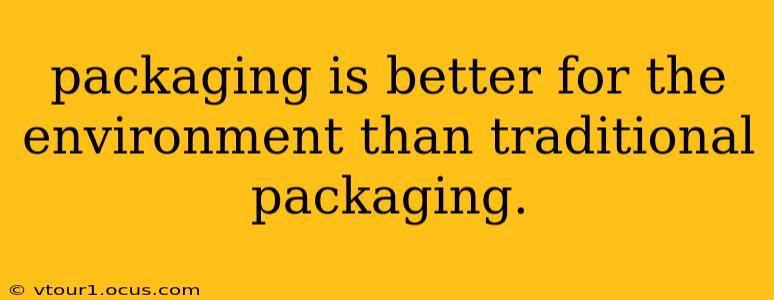The question of whether sustainable packaging is truly "better" for the environment than traditional packaging is complex. It's not a simple yes or no answer, as the environmental impact depends on numerous factors related to both the materials used and the entire lifecycle of the packaging. While sustainable packaging aims to minimize environmental harm, traditional packaging often relies on materials with significantly higher carbon footprints and longer decomposition times. Let's delve into the details.
What Constitutes "Sustainable" Packaging?
Before comparing, we need a clear definition. Sustainable packaging minimizes environmental impact throughout its entire life cycle – from raw material sourcing to manufacturing, distribution, use, and disposal or recycling. This involves considering factors like:
- Material Selection: Using recycled content, renewable resources (like bamboo or mushroom packaging), or biodegradable/compostable materials.
- Manufacturing Processes: Optimizing energy use and reducing waste during production.
- Transportation & Distribution: Minimizing transportation distances and fuel consumption.
- End-of-Life Management: Designing for easy recycling, composting, or biodegradation. This often involves clear labeling and readily available recycling infrastructure.
How Does Traditional Packaging Compare?
Traditional packaging often relies heavily on materials like:
- Plastics (polyethylene, polypropylene, polystyrene): These are derived from petroleum, a finite resource, and are notoriously slow to decompose, contributing to pollution in landfills and oceans.
- Non-Recycled Paper & Cardboard: While paper and cardboard are renewable, their production requires significant energy and water, and their environmental impact is increased if not recycled.
- Aluminum: Although recyclable, aluminum production is energy-intensive and releases greenhouse gases.
The environmental burden of traditional packaging is primarily due to:
- High Carbon Footprint: The energy required for extraction, manufacturing, and transportation of materials contributes significantly to greenhouse gas emissions.
- Waste Generation: Large volumes of non-biodegradable waste end up in landfills.
- Pollution: Plastic pollution is a significant global concern, impacting ecosystems and wildlife.
What are the Advantages of Sustainable Packaging?
Sustainable packaging offers several key environmental advantages:
- Reduced Greenhouse Gas Emissions: Using renewable resources and efficient manufacturing processes minimizes carbon footprint.
- Lower Waste Generation: Biodegradable or compostable materials reduce landfill waste.
- Conserved Resources: Utilizing recycled materials reduces the need for virgin resources.
- Improved Recycling Rates: Packaging designed for easy recycling increases the likelihood of successful recycling.
What are the Drawbacks of Sustainable Packaging?
It's crucial to acknowledge the limitations:
- Higher Initial Costs: Sustainable materials and processes can be more expensive than traditional options.
- Limited Availability: Some sustainable materials may not be readily available in all regions or for all applications.
- Performance Limitations: Certain sustainable alternatives may not offer the same level of protection or shelf life as traditional packaging.
- Recycling Infrastructure: The effectiveness of sustainable packaging depends on adequate recycling infrastructure; a compostable package is useless if there's no composting facility available.
Is Sustainable Packaging Always the Better Choice?
The "better" choice isn't universally sustainable packaging. It depends on a lifecycle assessment, considering the entire impact of both options for a specific product and region. In some cases, carefully managing and recycling traditional materials might be less impactful than using a less-efficient sustainable alternative. A thorough analysis considering energy consumption, material sourcing, transportation, and waste management is crucial.
How Can I Tell If Packaging Is Truly Sustainable?
Look for certifications and labels like:
- Compostable: Indicates the packaging can break down into organic matter in a composting facility.
- Recyclable: Shows the packaging can be recycled through established systems.
- Recycled Content: Specifies the percentage of recycled material used in the packaging.
However, always check the specifics of the certification and the local recycling infrastructure.
What are the Future Trends in Sustainable Packaging?
The packaging industry is constantly innovating. We can expect to see more:
- Bio-based plastics: Plastics derived from renewable resources like corn starch or sugarcane.
- Mushroom packaging: Lightweight, biodegradable packaging made from mycelium.
- Edible packaging: Coatings or films that are safe to consume along with the food.
- Smart packaging: Packaging integrated with sensors to monitor product condition and extend shelf life.
By carefully evaluating the environmental impacts throughout the entire lifecycle, consumers and businesses can make informed choices that promote a more sustainable future. The shift to sustainable packaging is a journey, not a destination, requiring continued innovation and collaboration across the entire supply chain.
